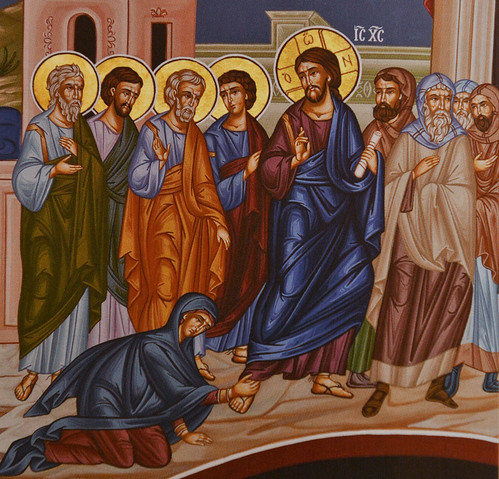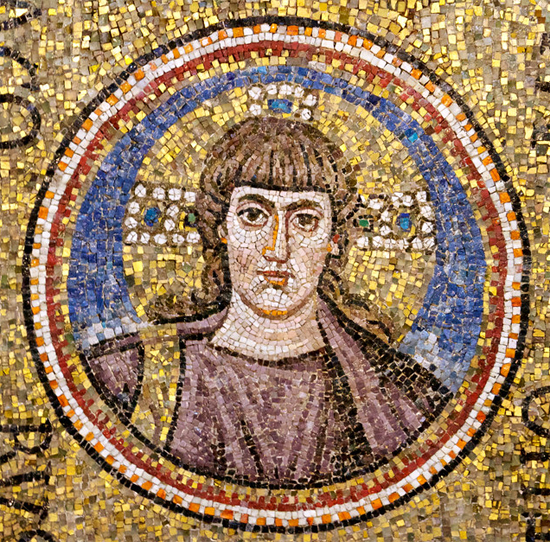Christian Art | Faith Healing The Canaanite Woman
Matthew 15: 21-28 – Week 18 Wednesday (King James Audio Bible KJV, Spoken Word)
21 ¶ Then Jesus went thence, and departed into the coasts of Tyre and Sidon.
22 And, behold, a woman of Canaan came out of the same coasts, and cried unto him, saying, Have mercy on me, O Lord, thou Son of David; my daughter is grievously vexed with a devil.
23 But he answered her not a word. And his disciples came and besought him, saying, Send her away; for she crieth after us.
24 But he answered and said, I am not sent but unto the lost sheep of the house of Israel.
25 Then came she and worshipped him, saying, Lord, help me.
26 But he answered and said, It is not meet to take the children’s bread, and to cast it to dogs.
27 And she said, Truth, Lord: yet the dogs eat of the crumbs which fall from their masters’ table.
28 Then Jesus answered and said unto her, O woman, great is thy faith: be it unto thee even as thou wilt. And her daughter was made whole from that very hour.
Jesus has withdrawn from Galilee, and from the jurisdiction of Herod Antipas, to Tyre and Sidon, Phoenician cities on the Mediterranean coast, in what is now Lebanon, there to escape persecution from Herod and the Jewish authorities, and to concentrate on training his apostles.
Most of the people of this area were pagans, i.e. they were not Jewish. In St Matthew’s Gospel, the woman who approaches Jesus is called a Canaanite. In St Mark’s, she is described as a Syrophoenician. She is, then, a pagan, and as such her faith in Jesus is all the more remarkable. Where many Jewish people have refused to believe in Jesus, a pagan woman acknowledges our Lord as the Son of David, the Messiah. The woman cries to Jesus: ‘Have mercy on me.’ Powerless, only expressing her need, she places herself utterly in Jesus’ hands.
The reaction of the disciples may perhaps be understood as one of alarm. There is a certain threat to Jesus and his disciples, and here there is a woman and a stranger risking exposure and incident, when privacy and peace are required. Jesus’ response might strike us as very strange. The initial, literal meaning of Jesus’ words is that he says he is only sent to recall the lost sheep who are the people of Israel to God – to God from whom they have wandered. Jesus’ meaning appears to be clear: he is not sent to the pagans.
This must seem very strange to us. We read in the Gospels of Jesus travelling to pagan lands to heal people there. There is a great sending of the disciples to all nations. It is told to us clearly that Jesus came to heal the whole of mankind. And yet now these verses confront us.
In some ways, the exchange that follows may read like a battle of wits. We recall that the people of Israel are the initially chosen people, through whom the whole of mankind is to be saved. Jesus’ mission is to advance the people of Israel along this path, to recall them from their sinful wanderings and to render them a fit vessel to carry God’s truth to all. We could say in this sense that Jesus’ first words here express the dynamic progression of the Gospels and the New Testament as a whole. The seed is sown among those elect of the people of Israel who come to live closely with Jesus, and the seed will grow to bear fruit for the whole world.
More immediately, Jesus has come to this place to train his disciples in safety. These are the ones who are included in the gesture, as Jesus speaks of his coming to save God’s first chosen people. There is humour here. There is a touch of gentle irony. There is also an invitation to the woman to show herself as being in close sympathy with Jesus’ mode of address and of thought.
The woman rides above the initial saying of Jesus. She sees Jesus’ words as a gateway, enabling her to beg to him. Then she is able to respond with wit and intelligence as well as faith to Jesus’ second saying. If she is a puppy – which is the meaning of the Greek, rather than ‘dogs’; it is much more light and affectionate in tone than most English translations have it – then even those little dogs are entitled to eat the crumbs that fall from their masters’ table. The woman has taken up Jesus’ aphorism and advanced it. This is faith and intelligence acting in unison. And Jesus is impressed! This Canaanite woman’s faith in this manner has made her daughter whole.
Concluding Prayer | Love Revealed By Jesus Christ
Nothing can separate us from the love of Christ, for he promised to be with his Church until the end of time. With confidence in his promise we pray: Stay with us, Lord Jesus.
Shed your light on our hearts, Lord,
so that walking continually in the way of your commandments,
we may never be deceived or misled.
We make our prayer through our Lord.
![]()
King James Audio Bible | Endnotes
What Does It Mean To Take The Children’s Bread And Cast It To The Dogs?
To understand what Jesus meant when he referred to the ‘children’s bread’ and ‘dogs,’ we must first consider the historical and cultural context of the passage. At the time of Jesus’ ministry, the Jews believed that they were God’s chosen people, and that the blessings of salvation were reserved for them alone. This exclusive mindset was reflected in the term ‘children’, which Jesus used to describe the Jews. The Canaanites, on the other hand, were regarded as outsiders and unworthy of God’s grace.
The term ‘dogs’ was commonly used in Jewish culture as a derogatory term for Gentiles, particularly the Canaanites. In the Old Testament, dogs were considered unclean animals, and their scavenging behaviour made them symbols of moral impurity. This negative connotation carried over into the New Testament, where dogs were associated with the enemies of God’s people (Philippians 3:2; Revelation 22:15).
Thus, when Jesus referred to the Canaanite woman as a ‘dog’, he was using a culturally ingrained metaphor to indicate that he viewed her as outside the circle of God’s chosen people. Jesus was suggesting that it was not appropriate to give the blessings of God’s grace to those who were not part of the Jewish community.
However, the woman’s response to Jesus’ statement demonstrated her faith and humility. She acknowledged her unworthiness and asked for even the crumbs that fell from the children’s table. This display of faith and persistence impressed Jesus, who praised her for her great faith and healed her daughter.
Interpretation of this passage has been the subject of debate among Christians. Some have argued that Jesus’ use of the term ‘dogs’ was intended to test the woman’s faith and provoke her to a deeper level of belief. Others have suggested that Jesus was demonstrating his willingness to extend salvation to all people, regardless of their background or ethnicity.
Catholic and Protestant theologians have offered various interpretations of this passage. For example, Saint Augustine of Hippo suggested that the woman’s faith was a demonstration of prevenient grace, which is the grace that prepares the heart to receive the gospel. In his commentary on Matthew, John Calvin argued that the woman’s faith was a sign of election, which is the doctrine that God chooses certain individuals for salvation.
Some have argued that it demonstrates Jesus’ willingness to challenge cultural norms and extend salvation to all people, regardless of their background or ethnicity. Others have suggested that it reveals the depth of faith that is required to receive God’s blessings.








